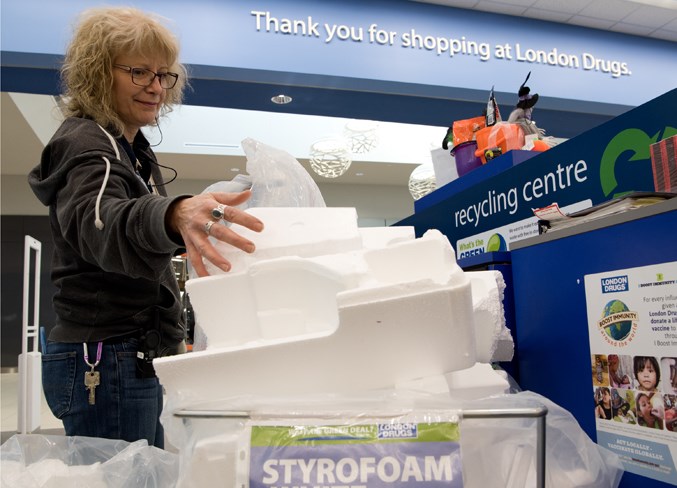St. Albert will learn this January how it can bring Styrofoam recycling to the masses.
City council supported a motion from Coun. Sheena Hughes Oct. 15 to have staffers bring back options by the end of January on ways to accept expanded polystyrene (the generic name for Styrofoam) at the city’s recycling depot.
Styrofoam is currently not accepted in the city’s curbside collection program or at its recycling depot. If you want to get rid of it, you either have to put it in your garbage cart or take it to London Drugs, which accepts it and many other forms of packaging.
Council approved changes to the city’s blue bag program last month in response to tighter restrictions on recyclable materials in international markets. As of Nov. 1, glass jars, single-use cups, plastic clamshells, spiral-wound containers and non-deposit Tetra Paks will no longer be accepted in the blue bag (although glass jars will still be accepted at the recycle depot).
While debating those changes, council heard that St. Albert could potentially recycle Styrofoam for about 50 cents per person per year. Hughes gave notice that she wanted the city to explore that option.
Hughes said one of the biggest complaints she gets from residents is how they’ll buy something and there will be a big chunk of Styrofoam in the box for them to cram into their trash bin.
“People in St. Albert are really passionate about recycling,” she said, and this is material that shouldn’t go in the landfill.
In a report to council, city utilities director Kevin Cole said Styrofoam is difficult to recycle, as it is expensive to transport due to its bulk and prone to breaking into bits that contaminated other materials. The city’s blue-bag contractor can’t process it, so any collection efforts would have to happen at the recycling depot.
“Our biggest concern right now is we don’t know the process (by which) they break the Styrofoam down,” Cole told council, adding that the process could be worse than landfill or produce fumes.
Cole said the city would look at accepting non-food-related Styrofoam at the depot as early as next year, with the city absorbing the first year’s costs.
How others do it
Only a handful of Alberta communities accept Styrofoam for recycling, said Christina Seidel of the Recycling Council of Alberta. Unlike glass, there’s definitely a market for it, and you can sell it if you can make it dense enough to transport.The Town of Cochrane was one of the first places in Alberta to recycle Styrofoam, and has done so since 2009. It now processes about 15 tonnes of the stuff each year, said Fabrizio Bertolo, the town’s waste and recycling manager.
Cochrane initially used a compressor to squish its Styrofoam down to size, but switched to a more efficient system in 2013, Bertolo said. The new system melts about four giant sacks of Styrofoam down at a time into one 20-pound, 40-by-20-by-five-centimetre brick. They typically produce about six bricks per day for shipment overseas.
“You don’t really make money,” he said, as it’s labour-intensive, but you probably break even once you account for your lower landfill fees.
Bertolo said the machine Cochrane uses does not produce any foul odours or noises, and can accept all forms of clean polystyrene except for certain kinds of insulation (such as spray-foam). He invited St. Albert officials to drop by to check it out.
“St. Albert is a really green municipality, so it would be really great for you guys to have (one of these).”




